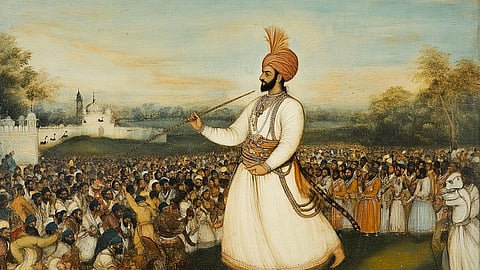- Commentary
- History Vignettes
- Notes on Culture
- Dispatches
- Podcasts
- Indian LanguagesIndian Languages
- Support

WHEN MUHAMMAD HĀDI arrived in Bengal, he was met with instant hostility. His boss, Azim-ud-din saw him as an upstart out to dismantle the sodden ancien regime controlled by the aforementioned corrupt oligarchs.
As the Subahdar of Bengal, and as Aurangzeb’s grandson, Azim-ud-din was presiding over an oily racket, which served a twofold purpose. The first was personal enrichment on a fabulous scale. The second was to use some of this wealth to stake his claim for succession to the Mughal throne.
When Aurangzeb appointed Azim-ud-din as the Subahdar in 1697, he was 79 years old. The grandson was just thirty-three, ambitious, crafty and ruthless. He had correctly foreseen that the old emperor wouldn’t last long. And when the bloody war for succession would erupt, he would be ready with men, money and muskets. However, Azim-ud-din’s ambition and political talents were not matched by tenacity and a capacity for sustained work. It was ambition which made him spend most of his time in Agra and Delhi, close to the seat of imperial power. He governed the Bengal Subaa through a network of loyal proxies.
More than anyone else, the French and the English East India Company in Bengal heavily capitalised on Azim-ud-din’s ambition. Both doled out heavy bribes to Azim-ud-din and his underlings and obtained lucrative monopolies and conducted trade on behalf of this Subahdaar. Azim-ud-din had a respectable-sounding name for it: sauda-i-khaas, loosely translated as the “personal trade of His Excellency, the Subahdaar.”
Sauda-i-Khaas has a chilling parallel in our own time in the form of something called “private treaties” instituted by the Times of India. It has since been rebranded as Brand Capital.
The so-called sauda-i-khaas wasn’t a terribly original innovation of Azim-ud-din. He was only continuing an evil precedent set earlier by Mir Jumla (the same Mir Jumla who melted Hindu murtis in Gandikota) and Shaista Khan. The sauda-i-khaas basically worked as follows. The person or company that held the monopoly got the absolute right to gain the exclusive possesion of all goods and merchandise at the place of its origin or the place of its unloading. These goods would then be sold at outrageous prices to retailers. Both the British and the French had a field day. The consequences were predictable: the ordinary people of Bengal were sucked dry.
When Aurangzeb received reports of this ruinous system, he wrote a letter to Azim-ud-din, gently chiding him. Here is an interesting excerpt from it:
The meaning of Sauda in Arabic is “madness.”
Aurangzeb’s scolding had the desired impact. Azim-ud-din unwillingly halted the corrupt practice and began looking for alternate sources for enlarging his personal treasure. The easiest and the most obvious method was to squeeze the proverbial common citizen. His officers unleashed a reign of terror against hapless peasants and traders and merchants and deposited their illicit extraction directly with Azim-ud-din. The State exchequer was thus deprived of its legitimate income right at the source. If this wasn’t enough, Azim-ud-din laid his hands on the Bengal treasury and flagrantly withdrew money beyond his sanctioned allowances and perks.
When Muhammad Hādi took charge as the Diwan of Bengal, he found that Azim-ud-din was widely despised as a lazy ruler and oppressive extortionist. Hādi’s mandate from Aurangzeb to quickly fix Bengal’s revenue would be daunting.
From the start, Azim-ud-din instigated his loyalists at all levels to make life miserable for Hādi. And they were only too glad to comply.
At every step, Hādi’s authority was openly challenged. He was defied, disobeyed, taunted and publicly humiliated especially by the low-ranking Kokas. But while they had access to the Mughal harem, Hādi had the unstinted confidence of Aurangzeb himself. And he used this power to the hilt.
Hādi delivered the first blow to Azim-ud-din by stopping his overdrawings from the treasury. In a simultaneous action, he stopped Azim-ud-din’s loyalists from directly extorting the peasants, etc. The furious grandson got the Kokkas to write letters of intercession to Aurangzeb, requesting him to overrule this arriviste Diwan’s decisions.
Aurangzeb did the exact opposite. He forwarded these letters to Muhammad Hādi and both men had a hearty laugh. One such correspondence is particularly revealing. The following are extracts from Aurangzeb’s letter to Hādi:
"You have written, ‘Partners in my work and other selfish people are openly boasting that in their reports to the imperial Court they would write whatever they thought proper and the zamindars on the spreading of this news, are withholding the payment of their due revenue.’ …
“I do not see your point clearly. You are diwan… with full power, and nobody’s allegation against you is acceptable to me. Why do you entertain doubts about my trust in you, prompted by Shaitaan? Who are your ‘partners’ and what is their objective? Keep in view my favour and instructions, give no place to apprehension in your heart, and exert yourself even more earnestly than before in collecting the revenue.”
This was all that Muhammad Hādi needed. In a series of deft moves, he replaced Azim-ud-din’s loyalists in key positions with his own appointees.
A seething Azim-ud-din saw the writing on the wall but decided not to give up so easily. Muhammad Hādi had to be eliminated.
What happened next will be narrated in the next episode of this series.
To be continued
The Dharma Dispatch is now available on Telegram! For original and insightful narratives on Indian Culture and History, subscribe to us on Telegram.
